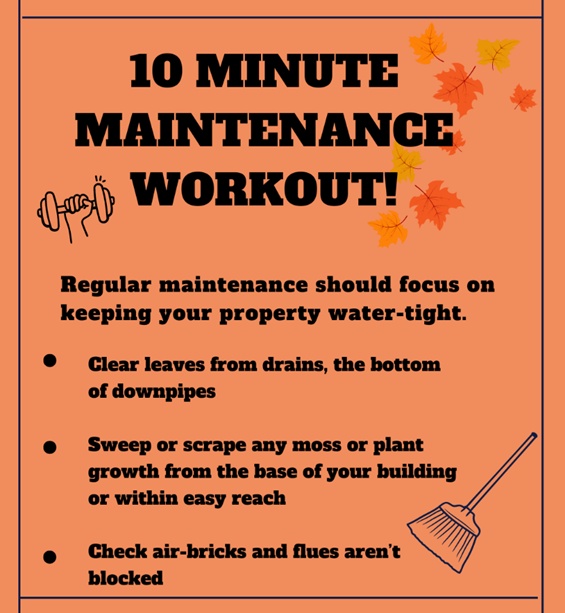Maintaining historic properties
Maintenance moments
Ideally, you should complete a full visual inspection of your buildings at least once a year.
Autumn is a good time to do a thorough maintenance check, ensuring your property is ready for winter.
However, it is important to regularly inspect your building, particularly after periods of extreme weather such as storms, snow or drought.
Try our 10 minutes maintenance workout!

Make sure you stay safe, and only carry out maintenance work if you feel confident. If in doubt, call in help.
There are numerous resources available to help you plan regular maintenance through the year.
A great place to start is the SPAB Maintenance Matters campaign. Every November, they run a week long campaign to raise awareness of the importance of maintenance. Look out for helpful resources, such as this calendar of simple checks you can do to maintain your building. There is also practical advice such as Maintenance tips to keep your home warm and dry in winter.
Historic England have a useful illustrated maintenance checklist on their website. We have also produced a Maintenance Checklist. You can print this off and complete it yourself, or use as a basis to instruct a tradesperson or handyman.
The SPAB Knowledge Base has guidance on a range of maintenance topics including roof, windows and floor maintenance. Preventative maintenance is also important, such as cold weather precautions.
You may be able to carry out some maintenance checks yourself. Here are some top tips!
- Be systematic.
- Start with the exterior of the property and inspect from top to bottom. Use the printable checklist or SPAB’s more detailed template.
- Ideally carry out the inspection in the rain, it’s much easier to tell if a gutter is blocked!
- Take lots of photos, they can be useful to include when getting quotes for work.
- Use binoculars to inspect roofs and upper floors- only attempt to inspect from ladders or scaffolding if you are confident, trained and have well maintained equipment.
- If in doubt, call someone in to help.
- Carry a torch or camera or phone with a flash for seeing in dark and hard to access places.
- Watch out for slippery bits- wear boots with good grip and gloves if inspecting cellars or little accessed areas.
- Don’t stand in the road! Or, if it can’t be avoided, inspect at a quiet time and wear high visibility clothing.
- View and download our handy Maintenance Checklist.
